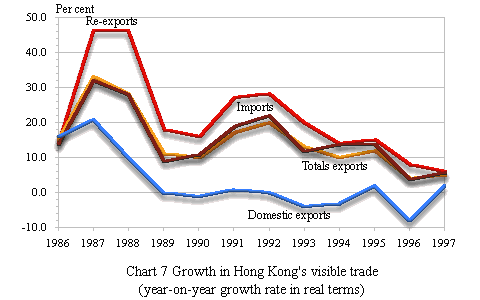External Trade
Total exports grew by 6 per cent in real terms in 1997, slightly better than
the 5 per cent growth in 1996. Growth in the second half of the year was
faster than in the first half. In particular, there was a notable recovery in
domestic exports.
Within total exports, re-exports rose by 7 per cent in 1997, slightly slower
than the 8 per cent increase in 1996. This was nevertheless compensated
by a marked recovery in domestic exports, reversing an 8 per cent decline
in 1996 to an increase of 2 per cent in 1997. Given the heavier weighting
of re-exports in total exports, the share of re-exports in this total remained
virtually unchanged, at 85 per cent in both 1996 and 1997,
notwithstanding the pick-up in domestic exports between these two years.
Exports to the two largest markets - the USA and the Mainland - showed
notable growth of 8 per cent and 9 per cent respectively in 1997,
underpinned by the generally robust demand in these two economies. On
the other hand, exports to Japan and the UK slackened considerably from
the preceding year. Their respective growth rates were minus 1 per cent
and 5 per cent. Exports to Germany also weakened further, declining
2 per cent. The substantial currency depreciation in the East Asian
economies since mid-1997 have not materially affected Hong Kong's
overall export performance so far.
Chart 7 Growth in Hong Kong's visible trade
(year-on-year growth
rate in real terms) Export performance was slightly better in 1997,
with re-exports growing moderately and domestic exports recovering
markedly.

Consumer goods, and raw materials and semi-manufactures remained the
two largest end-use categories of Hong Kong's exports, accounting for
48 per cent and 29 per cent respectively of the total value in exports in
1997. This was followed by capital goods (20 per cent).
In the first three quarters of 1997, seaborne outward transshipment
rebounded strongly by 9 per cent in tonnage terms over a year earlier, in
contrast to a 3 per cent decline in 1996. This reflected the accelerated
development of offshore trading in Hong Kong's external trade. Analysed
by market, transshipment to the USA and Taiwan rose substantially, both
by 16 per cent. This was followed by the Mainland, with an increase of
14 per cent. On the other hand, transshipment to Japan showed only
modest growth of 2 per cent, while transshipment to Singapore, Germany
and the UK fell by 8 per cent, 19 per cent and 21 per cent respectively.
Analysed by major commodity group, manufactured goods continued to
account for the largest share of seaborne outward transhipment, at
44 per cent in tonnage terms in the first three quarters of 1997. This
was followed by chemicals and related products (18 per cent), crude
materials (13 per cent), machinery and transport equipment (12 per cent),
and foodstuffs (11 per cent).
Imports rose by 7 per cent in real terms in 1997, faster than the
corresponding increase of 4 per cent in 1996. This was mainly attributable
to a strong revival in retained imports by 9 per cent in real terms in the
first three quarters of 1997 for both consumption and production
purposes. However, retained imports underwent a significant deceleration
in growth to only 3 per cent in the fourth quarter, as domestic demand
slackened against the adverse effect of the regional financial turmoil. The
Mainland remained the largest source of Hong Kong's imports, accounting
for 38 per cent of the total value in 1997. This was followed by Japan
(14 per cent), the USA (8 per cent), and Taiwan (8 per cent).
Due in part to a larger intake of raw materials and semi-manufactures and
of capital goods for production and business expansion in the early part
of 1997, the visible trade deficit widened to $159 billion or 9.9 per cent
of the total value of imports in 1997. The corresponding figures in 1996
were $138 billion or 9 per cent. The visible trade deficit nevertheless
narrowed in the latter part of the year, falling from a peak of 13.3 per cent
against the value of imports in the first quarter to 7.5 per cent in the
fourth quarter.
As to invisible trade, mainly affected by the setback in inbound tourism
since the middle of 1997, the value of exports of services weakened
considerably to virtually zero growth in 1997. On the other hand, the
value of imports of services increased by about 6 per cent in 1997. Yet
with the former still much larger than the latter, a substantial invisible
trade surplus of around $113 billion was still attained in 1997, which
helped offset a large part of the deficit on the visible trade account.
[Back] [Forward]
|